Murchison Radio-astronomy Observatory News

March 2021


So long 2020! Welcome to 2021!
Hi everyone,
I hope you all had an excellent Christmas and were able to enjoy the season in whatever format that may take for you. It would seem 2020 has not quite loosened its grip on us yet, with us in the greater Perth area experiencing a snap lockdown in February, which in context was a mild inconvenience for us by comparison to some of our interstate friends. Nonetheless, it still managed to mess with our plans to get to the MRO at that time.
We have been pleased to hear some positive reports of decent rain throughout the region. Equally, with the rain comes the damage to the roads and tracks that keeps us connected. We’re aware that some of the roads have seen an amount of rain damage, with the Roderick impassable for a number of days. We are very grateful for the Shire’s regular updates on the conditions so we can safely travel. Many thanks to William and the Shire of Murchison team for their tireless efforts in this regard.
I recently attended the Mid-West Economic Summit in Geraldton and enjoyed the diverse range of speakers. It’s interesting to see the focused future opportunities for the Mid- West region, and our thanks to the Mid-West Chamber of Commerce and Industry for the informative opportunity.
It is with sadness that I announce that Kevin Ferguson is moving east to take up a new role. Kevin has been instrumental (pun intended) with the operations of CSIRO’s ASKAP radio telescope on the MRO, and we will greatly miss Kevin’s questionable Scottish humour, positive demeanour, and general guidance. We wish him all the best in his exciting new role. Kevin has provided some words of farewell below.
As always, should you wish to contact me or a member of my team, please email me Rebecca.wheadon@csiro.au, Geoff Geoffrey.king@csiro.au, or Chris Chris.brayton@csiro.au.
Rebecca Wheadon, CSIRO

I leave WA with so many wonderful memories, many of which will be everlasting.
It has been a little while since I have produced some words for the MRO Newsletter, but I wanted to take this opportunity to let you know that I have recently been offered a new role within CSIRO, and to say thank you to all of you, for your support and engagement with CSIRO’s activities on the MRO during my time here.
It has been both wonderful and a genuine pleasure to meet you and work alongside many of you during this time. I leave WA with so many wonderful memories from my many interactions across the last five years with you, many of which will be everlasting.
The memory of the Ballinyoo Bridge Opening in September 2016, with the marquee tent that stretched across the full length of the bridge, has been etched into my brain and is a true testimony to the collective and supportive approach that can only be found in regions such as the Murchison.
Leading the MRO Open Days in October 2018 was also particularly wonderful as it has been the only opportunity to-date for CSIRO to enable large attendances by the general public to visit the MRO and experience it for themselves.
I mentioned above that I am leaving WA. In May, my family will be relocating to Canberra to enable me to take up the position of Director, Canberra Deep Space Communications Complex (CDSCC) located at Tidbinbilla, ACT.
I am truly saddened to leave WA, a place of great beauty and wonderful people, particularly those I have worked with very closely over the years. However, having previously lived and worked in Canberra, my family and I are hopeful that we remember and appreciate what we are returning to, particularly the lifestyle activities made possible when the temperature drops way below zero!
I am sincerely grateful for your support over the last five years and I wish you all a healthy and successful future.
Soraidh – farewell, and stay safe.
Kevin Ferguson, CSIRO
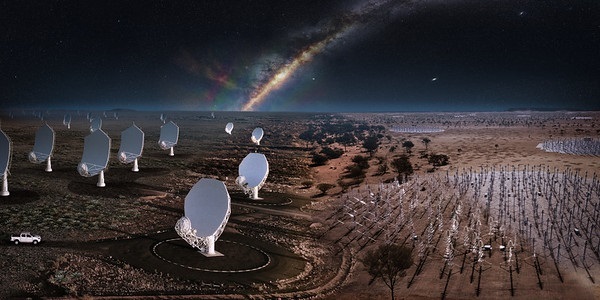
Current timelines show construction work ‘on-the-ground’ starting at the MRO in early 2022.
As you may be aware, the Square Kilometre Array Observatory (SKAO) was officially launched on 4 February 2021. Australia is one of the founding members of the Observatory, alongside the United Kingdom, South Africa, Italy, the Netherlands, and Portugal. Ten other countries are in the process of joining.
This is a significant milestone as the SKAO is only the second intergovernmental organisation dedicated to astronomy. It is the international body that will now receive construction funds, and place contracts for the construction and operation of the SKA telescopes. Current timelines have construction activities (e.g. the tendering of contracts) commencing around the middle of 2021 with work ‘on-the-ground’ starting at the MRO at the beginning of 2022.
As we head towards construction, I am delighted to welcome Anthony Holzwart as the Australian Industry Liaison Officer for the SKA. Anthony is a ‘Growth Facilitator’ with the Australian Government’s Entrepreneurs’ Programme, with experience helping businesses understand and make the most of supply opportunities. Anthony and the Australian SKA Office will work together to raise awareness of the SKAO opportunities and help Australian businesses to better understand them.
The first contracts to be tendered by the SKAO will relate to the development of SKA infrastructure at the MRO. In many cases, to be considered for these contracts, organisations will first need to respond to ‘market surveys’ that will be advertised on the SKAO’s web portal (once it has been created). While some large contracts will be best suited to large businesses, these are likely to create opportunities for local subcontractors.
If you would like to be kept informed of industry opportunities as they arise, I highly recommend joining our industry group, the Australasian SKA Industry Cluster (ASKAIC). To join, go to www.ska.gov.au and follow the link under ‘Connect with us’.
I look forward to updating you on the SKA’s progress as we approach construction.
Ben Scandrett
Australian SKA Office, DISER
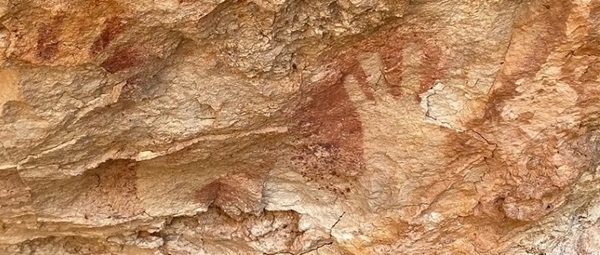
Heritage surveys of the SKA Australia site are ongoing and will ensure the project has minimal impact on the lands of the Wajarri people.
Progress continues in preparation for construction of the SKA. Recently, additional heritage surveys have occurred as part of the process to ensure the project has minimal impact on the lands of the Wajarri people.
The image below shows red Ochre hand stencils in a breakaway overhang. The location was observed while surveying a proposed trench route for power and fibre cables. It’s an example of the type of area the Wajarri Yamatji community, CSIRO and DISER are wanting to preserve and protect. The highly weathered rock (possibly white decomposed granite) had eroded away and receded back into the rock face creating an overhang and a natural rock shelter. The photo was taken by CSIRO’s Kerry Ardern, who's a member of the 'walkover' team.
Further work has also occurred in environmental studies. The administrative aspects of the process are largely ready for completion later in 2021.
Ant Schinckel, CSIRO
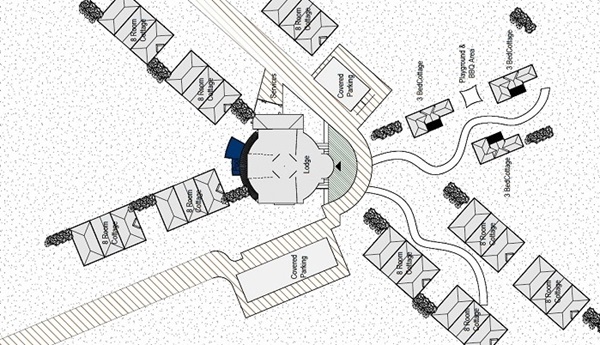
CSIRO has been working with industry partners on some concept designs for an SKA accommodation facility at Boolardy.
The CSIRO-led SKA Australia infrastructure team is working closely with the SKA Observatory (SKAO) to develop the material for briefing industry and preparing tendering related information. As mentioned by Ben, the opportunities for Australian industry will be publicised through the ASKAIC group, as well as on SKAO’s own website. For more information and details as they become available, please ensure you’ve signed up to the ASKAIC at ska.gov.au.
SKA infrastructure work at the MRO will include installing power and fibre networks, tracks and roads, specialised shielded buildings and site communication and a temporary construction camp for around 200 people. Recently, we've been working with Aurecon and CCN on concept designs for a new SKA accommodation facility at Boolardy. The image below shows one of the possible layouts.
Ant Schinckel, CSIRO
It's business as usual with all the MRO (Boolardy) asset maintenance contracts at the moment. In the coming months, we're expecting to do some further work on the CSIRO ASKAP control building's cooling infrastructure, and we'll be scheduling this with existing service providers.
CSIRO contributed to the Large Feral Herbivore Animal Program in mid-December 2020 and this was scheduled at a time favourable to the telescope's science and operations teams. From all reports it has been successful and although recent rainfall has prevented completion, follow-up activity will be scheduled when conditions are appropriate.
The procurement process for the Boolardy Services and Logistics Contract has been finalised, with the award of the contract going to Wajarri Pacific Services Group Joint Venture. This engagement is in line with Commonwealth procurement practices and guidelines.
Geoff King, CSIRO
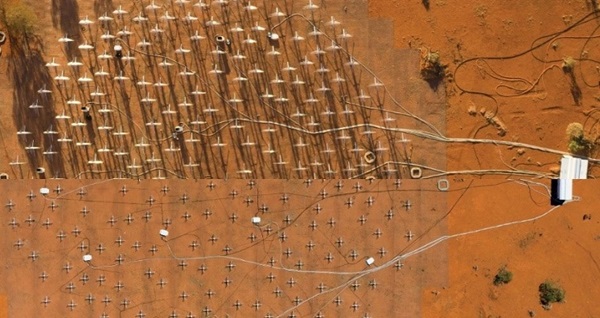
A Curtin University Summer student has already been able to detect 23 pulsars from sky observations made with the test arrays
It’s hard to believe the SKA-Low prototype stations (AAVS2 and EDA2) were built almost two years ago - but they’ve not been sitting idle!
Engineers from Curtin University and Italy’s National Institute for Astrophysics (INAF), have been monitoring the performance of the antennas to make sure they meet the high standards of the SKA. This ‘reality testing’ is an important step to work out any design kinks before more than 130,000 antennas are deployed in the Murchison.
The MRO has lots of advantages as the site chosen for SKA-Low, but it also poses some challenges. We don’t need to tell you how hot it can get out there, which can be a problem for very sensitive equipment. A recent upgrade was made to reduce the operating temperature of some field electronics. This this was a great success and will be rolled into the final SKA-Low system design.
Having the two different prototypes has been an excellent comparison tool for checking the quality of the instruments and troubleshooting any issues. And the data being collected isn’t just for engineers, it’s for scientists too!
A Curtin Summer student has already been able to detect 23 pulsars from sky observations made with the test arrays! This goes to show that it is already a powerful instrument and it’s exciting to think of what the full SKA will achieve.
Check out a video about the these instruments: https://youtu.be/sZqylS4Jo8s (Note that these facilities, AAVS, EDA etc are test arrays and prototypes for the SKA, built on the MRO near MWA and are not part of the SKA).
Mia Walker, Curtin University
Image: A composite image showing two halves of the SKA-Low prototype arrays, AAVS2 (left) and EDA2 (right). Image credit: ICRAR/Curtin
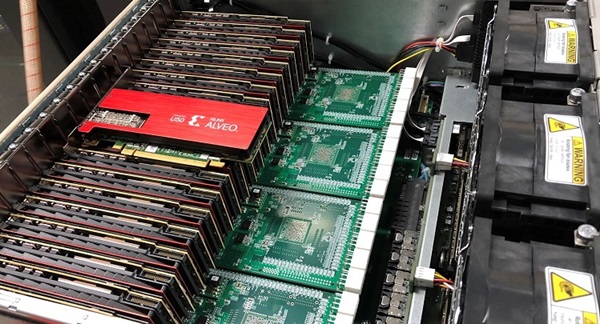
The SKA-Low correlator will combine incoming signals from the telescope’s 512 antenna stations, to form 504 beams, and generate 500,000 ‘visibilities’ (the data that's processed to form astronomical images).
Our readers like to know what the SKA telescope developers are 'doing', so here's another peak behind the engineering curtain!
Several Australia-based engineering teams are working in collaboration with local and international partners to develop the digital ‘back end’ of the SKA-Low telescope. By the ‘back end’, we mean everything that happens after the radio signals flow from the antennas at the MRO to the supercomputer in Perth.
The central signal processing (CSP) team, led by Grant Hampson at CSIRO, is building the correlator and beamformer (colloquially known as the ‘brain’ of the telescope) which combines incoming signals from the telescope’s 512 antenna stations, to form 504 beams, and generate 500,000 ‘visibilities’ (the data that is processed to form astronomical images).
In the lead-up to construction, the engineering teams are connecting parts of the back-end and running tests to see if they work on a small scale. CSP recently integrated two SKA-Low backend ‘sub-elements’; the Correlator and Beamformer, and the Pulsar Timing Engine (which ‘times’ known pulsars to high accuracy). The test was successful and the team was delighted to receive positive feedback about their progress from the SKA Deputy Director General.
Inside the SKA Integration Facility at CSIRO, the Assembly, Integration and Verification (AIV) team has been testing SKA prototype subsystems. Recently expanded, the facility is being configured in a way to mimic the real system. Engineers have been feeding simulated telescope data into the system and producing a valid measurement set – which means it is working as modelled!
YANDA (Wajarri word for picture) is the name of the SKA-Low software and computing team which is comprised of members from CSIRO and the University of Western Australia. This team has been working on extending existing software from ASKAP and the MWA for the SKA. This software already runs on a supercomputer at the Pawsey Centre in Perth but the SKA will need a much larger supercomputer to process the SKA data, which will be 100 times larger than the data from the existing telescopes – for which the Pawsey Centre is preparing.
Much of this SKA-Low engineering work is focussed at the integration centre, currently located in Sydney, where the various parts of the ‘back-end’ are being brought together on a small scale. This effort involves CSIRO collaborating with SKA partner institutes such as ASTRON in the Netherlands, SKA industry partners, and university partners in Australia and overseas.
Annabelle Young with input from CSIRO SKA Team Leaders.
Image: The chosen hardware platform for the SKA-Low correlator and beamformer is the Xilinx Alveo FPGA processing card, designed for computing in data centres. The firmware is mostly developed in a low level language called VHDL. The software is being developed in conjunction with the SKA Tango monitoring and control system.
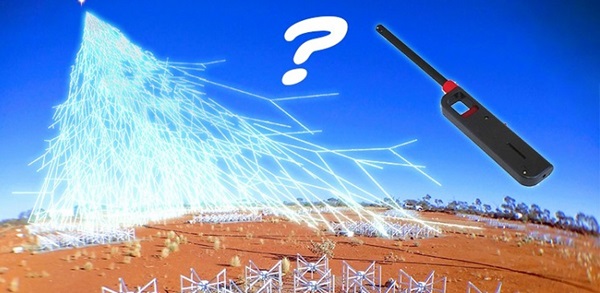
What do cosmic rays, gas lighters and the MWA telescope have in common?
For most people, the Christmas break is a time to relax, and for a few weeks the MRO site is also quiet of any activity. But for a lot of astronomers, the science never stops! A flurry of exciting MWA papers have been released in recent weeks, from observations of a giant black hole, to the first radio evidence of the cosmic web (the structure of the Universe), and a brand-new method of processing data in order to detect mysterious signals called cosmic rays.
That last one involved a particularly ingenious experiment with a gas lighter to test the system. When you click a lighter, it produces a spark- but also a tiny burst of radio waves that are similar to the ones from cosmic rays! It’s funny to think that a student walking around the MWA antennas clicking a gas lighter was an important step in the path towards a cutting-edge science method, and hopefully some amazing discoveries.
Check out our Facebook page to read more and stay up to date on MWA news.
Mia Walker, Curtin University
Image: MWA Image caption: What do cosmic rays, gas lighters and the MWA telescope have in common? Credit: Curtin and MWA Collaboration.
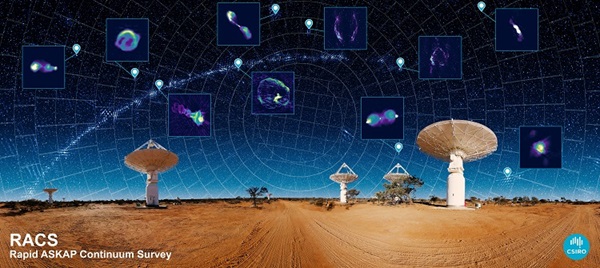
Our first all-sky survey, the Rapid ASKAP Continuum Survey (RACS), has been completed in record speed and detail, creating a new atlas of the Universe - like Google Maps in space! The collection of images contains almost 3 million galaxies, a million of which have never been seen before.
We’ve been ramping up operations over the past year and have just published the results of ASKAP’s first ever all-sky survey! As a precursor to the SKA, ASKAP uses advanced multi-beam technology to give radio astronomers a new, rapid survey capability at frequencies between 700 MHz and 1.8 GHz.
Rapid surveys are like panoramic photographs – the telescope assembles a gigantic map of the sky over the Murchison by stitching together about a thousand individual images taken one at a time. ASKAP’s high-tech receivers give the telescope a wide field of view (like a wide-angle lens), allowing it to complete an all-sky survey very quickly compared to previous technology.
Our first all-sky survey is called RACS – the Rapid ASKAP Continuum Survey. As the name implies, the goal of this project was to break a new speed record for a large-scale radio sky survey. The ASKAP team accomplished this with flying colours by mapping over 80% of the entire celestial sphere in about 300 hours, with sensitivity and resolution better than any previous survey at these frequencies.
903 individual images were taken with ASKAP, each having an exposure time of 15 minutes. The collection of images contains almost 3 million galaxies beyond the Milky Way, about a million of which have never been seen before. Explore RACS using this CSIRO interactive map of the southern sky.
Over the next five years, ASKAP will be conducting several more all-sky surveys designed to look much further out into the Universe. Instead of 15-minute observations, we will track each field for 10 hours or more. This will make very faint objects visible, leading to the discovery of tens of millions of new galaxies. ASKAP’s sky maps will make the task of commissioning and testing the SKA itself much easier, while advancing our knowledge of astrophysics and refining the big questions that the SKA will be able to answer.
Aidan Hotan, CSIRO
Image: ASKAP's first all-sky survey, called the Rapid ASKAP Continuum Survey or RACS. Data from RACS in the direction of the South celestial pole, shown with the telescope in the foreground. Close-ups of a few interesting radio sources are shown at full resolution, with a pointer marking their position on the sky.
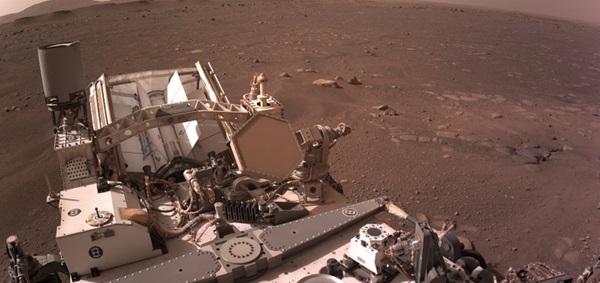
With the Autumnal Equinox on 20 March, expect day and night to be almost equal in duration.
The Autumnal Equinox falls on 20 March, with the Sun rising due East, setting due West, and day and night almost equal in duration.
Mars is the prominent planet visible in the evening sky, clearly visible as a reddish-looking object. Early in the month it is near the Pleiades cluster, otherwise known as the Seven Sisters, in the constellation of Taurus. On 19 March, it is close to the waxing crescent Moon and even closer on 17 April.
Mars is very much in the news at present! On Friday 19 February, after an eight-month voyage of 327 million kilometres, the NASA Perseverance rover landed successfully on Mars. CSIRO Manages the Canberra Deep Space Communication Complex (CDSCC) on behalf of NASA (where Kevin is soon to be working). As one of the three Deep Space Network stations around the world, it provides a vital role in tracking and communicating with deep space missions including the Mars Rovers, such as Perseverance.
You can keep up to date with the latest from Perseverance at https://mars.nasa.gov/mars2020/ and once there check out the stunning video footage of the landing.
Details about CDSCC are at: https://www.cdscc.nasa.gov/
Early risers can view Jupiter, Saturn, and Mercury in the eastern dawn sky.
Early March will provide the best views of Mercury for the year with it being within half a degree (the width of the Moon) of Jupiter on 5 & 6 March.
Robert Hollow, CSIRO
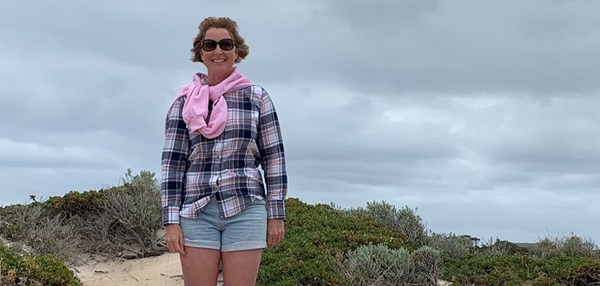
My career with CSIRO has been a long and varied one, working for a total of 17 years, for three divisions, located at four sites, in two States.
I recently started with CSIRO Astronomy and Space Science (CASS) as an administration officer in the Site Entity team. I work closely with Chris, Rebecca and Geoff and assist the team with CSIRO processes, to keep the project progressing forwards.
My career with CSIRO has been a long and varied one, working for a total of 17 years, for three divisions, located at four sites, in two States.
My first job with CSIRO was as a laboratory technician within the division of Agriculture and Food at the Floreat site. I enjoyed meeting and working closely with farmers to assist them with their agriculture challenges. The two long term projects I worked on was offering sheep saltbush as a novel feed alternative over the hot, dry Summer months, and a project determining the optimum food that needs to be on offer for pregnant and lactating sheep.
I then moved with my young family to Tasmania and worked for a brief time on a forestry trial to deter possums within plantations. We returned to WA and I started back at CSIRO as a support officer within Agriculture and Food acting as a bridge between scientists, staff and clients.
After eight years, I had the opportunity to “jump the fence” into Health and Safety (HSE). My laboratory background, along with the project support role enabled me to help drive improvements to workplace HSE.
Now I’m on a steep learning curve to understand the MRO people and project needs and look forward to getting to the Murchison soon, meeting the people and seeing the red dirt.
Outside of work I enjoy surf lifesaving, playing musical instruments, gardening, and camping with my family.
Simone Janney, CSIRO
CSIRO acknowledges the Wajarri Yamatji as the traditional owners of the MRO site.